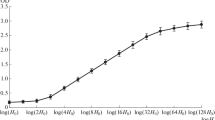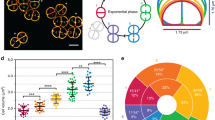Summary
The fine structure ofAmoeba proteus nuclei has been studied during interphase and mitosis. The interphase nucleus is discoidal, the nuclear envelope is provided with a honeycomb layer on the inside. There are numerous nucleoli at the periphery and many chromatin filaments and nuclear helices in the central part of nucleus.
In prophase the nucleus becomes spherical, the numerous chromosomes are condensed, and the number of nucleoli decreases. The mitotic apparatus forms inside the nucleus in form of an acentric spindle. In metaphase the nuclear envelope loses its pore complexes and transforms into a system of rough endoplasmic reticulum cisternae (ERC) which separates the mitotic apparatus from the surrounding cytoplasm; the nucleoli and the honeycomb layer disappear completely. In anaphase the half-spindles become conical, and the system of ERC around the mitotic spindle persists. Electron dense material (possibly microtubule organizing centers—MTOCs) appears at the spindle pole regions during this stage. The spindle includes kinetochore microtubules attached to the chromosomes, and non-kinetochore ones which pierce the anaphase plate. In telophase the spindle disappears, the chromosomes decondense, and the nuclear envelope becomes reconstructed from the ERC. At this stage, nucleoli can already be revealed with the light microscope by silver staining; they are visible in ultrathin sections as numerous electron dense bodies at the periphery of the nucleus.
The mitotic chromosomes consist of 10 nm fibers and have threelayered kinetochores. Single nuclear helices still occur at early stages of mitosis in the spindle region.
Similar content being viewed by others
References
Chalkley, H. W., Daniel, G. E., 1933: The relation between the form of the living cell and the nuclear phases of division inAmoeba proteus (Leidy). Physiol. Zool.6, 592–619.
Chambron, P., 1978: The molecular biology of the eukaryotic genome is coming of age. Cold Spring Harbor Symp. Quant. Biol.42, 1209–1234.
Daniels, E. W., 1973: Ultrastructure. In: The Biology of Amoeba (Jeon, K. W., ed.). New York and London: Academic Press.
Desportes, I., 1970: Ultrastructure des Grégarines du genreStylocephalus: la phase enkystée. Ann. Sci. Nat., Zool.12, 73–169.
Feldherr, C. M., 1966: Nucleoplasmic exchanges during cell division. J. Cell Biol.31, 199–203.
Flickinger, Ch. J., 1973: Cellular membranes of amoeba. In: The Biology of Amoeba (Jeon, K. W., ed.). New York and London: Academic Press.
Flickinger, Ch. J., 1974: The fine structure of four “species” ofAmoeba. J. Protozool.21, 59–68.
—, 1977: Relationships between membraneous organelles in amoeba studied by electron microscopic cytochemical stainings. Cell Tiss. Res.180, 139–154.
Gall, J. G., 1981: Chromosome structure and the C-value paradox. J. Cell Biol.91, 3s-14s.
Garber, R. C., Aist, J. R., 1979: The ultrastructure of mitosis inPlasmodiophora brassicae (Plasmodiophorales). J. Cell Sci.40, 89–110.
Goldstein, L., Ko, C., 1978: Identification of the small nuclear RNAs associated with the mitotic chromosomes ofAmoeba proteus. Chromosoma (Berl.)68, 319–325.
Heath, I. B., 1980: Variant mitoses in lower eukaryotes: indicators of the evolution of mitosis? Int. Rev. Cyt.64, 1–80.
Howell, W. M., Black, D. A., 1980: Controlled silver-staining of nucleolar organiser region with a protective colloidal developer: a 1-step method. Experientia36, 1014–1015.
Inoué, Sh., 1981: Sell division and the mitotic spindle. J. Cell Biol.91, 131s-147s.
Lesson, T. S., Bhatnagar, R., 1975: Microfibrillar structures in the nucleus and cytoplasm ofAmoeba proteus. J. exp. Zool.192, 265–270.
Makhlin, E. E., Kudryavtseva, M. V., Kudryavtsev, B. N., 1979: Peculiarities of changes in DNA content ofAmoeba proteus during inerphase. Exp. Cell Res.118, 143–150.
Maupin, P., Pollard, T. D., 1983: Improved preservation and staining of HeLa cell actin filements, clathrin-coated membranes, and other cytoplasmic structures by tannic acid-glutaraldehyde-saponin fixation. J. Cell Biol.96, 51–62.
Minassian, I., Bell, L. G. E., 1976 a: Studies on changes in the nuclear helices ofAmoeba proteus during the cell cycle. J. Cell Sci.20, 273–288.
Minassian, I., Bell, L. G. E., 1976 b: Timing of nucleolar RNA replication inAmoeba proteus. J. Cell Sci.22, 521–530.
Mollenhauer, H. H., 1964: Plastic embedding for use in electron microscopy. Stain Technol.39, 111–114.
Ord, M. J., 1979 a: The effects of chemicals and relation within the cell: an ultrastructural and microsurgical study usingAmoeba proteus as a single-cell model. Int. Rev. Cyt.61, 229–281.
—, 1979 b: The separate roles of nucleus and cytoplasm in the synthesis of DNA. Int. Rev. Cyt. suppl.9, 221–277.
Page, F. C., Kalinina, L. W., 1984:Amoeba leningradensis n. sp. (Amoebida): A taxonomic study incorporating morphological and physiological aspects. Arch. Protistenk.128, 37–53.
Prescott, D. M.,Carrier, R. F., 1964: Experimental procedures and cultural methods forEuplotes eurystomus andAmoeba proteus. In: Methods in Cell Physiology (Prescott, D. M., ed.).1, 85–95.
Raikov, I. B., 1982: The Protozoan Nucleus. Morphology and Evolution. Wien-New York: Springer.
Roth, L. E., 1967: Electron microscopy of mitosis in amebae. III. Cold and urea treatments: a basis for tests of direct effects of mitotic inhibitors on microtubule formation. J. Cell Biol.34, 47–59.
—,Obetz, S. W., Daniels, E. W., 1960: Electron microscopic studies of mitosis in amebae. I.Amoeba proteus. J. biophys. biochem. Cyt.8, 207–220.
—,Pihlaja, D. I., Shigenaka, Y., 1970: Microtubules in the heliozoan axopodium. I. The gradion hypothesis of allosterism in structural proteins. J. Ultrastruct. Res.30, 7–37.
Author information
Authors and Affiliations
Rights and permissions
About this article
Cite this article
Gromov, D.B. Ultrastructure of mitosis inAmoeba proteus . Protoplasma 126, 130–139 (1985). https://doi.org/10.1007/BF01287679
Received:
Accepted:
Issue Date:
DOI: https://doi.org/10.1007/BF01287679




